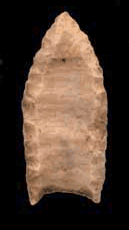Folsom Site facts for kids
|
Folsom Site
|
|

|
|
| Nearest city | Folsom, New Mexico |
|---|---|
| Area | 10 acres (4.0 ha) |
| NRHP reference No. | 66000473 |
Quick facts for kids Significant dates |
|
| Added to NRHP | October 15, 1966 |
| Designated NHL | January 20, 1961 |
The Folsom Site, also known as Wild Horse Arroyo, is a very important archaeological site located about 8 miles (13 km) west of Folsom, New Mexico. It's famous because it's the main place where we learned about the Folsom tradition. This was a culture of early people, called Paleo-Indians, who lived between 9000 BC and 8000 BC.
In 1926, scientists dug up the Folsom Site. They found a place where 23 bison had been killed near a marsh. The people who hunted them used special tools called Folsom points. This site was a huge discovery! It was the first time that tools clearly made by humans were found right next to bones of an extinct type of bison. This discovery helped archaeologists understand that Native Americans arrived in North America much earlier than they first thought.
Discovery of the Folsom Site
A cowboy and ranch foreman named George McJunkin found the site in 1908. He was an ex-slave who loved learning about geology and archaeology. After a very big rainstorm on August 27, he was riding his horse on the Crowfoot Ranch. The storm had caused a flash flood that cut deep into the ground of Wild Horse Arroyo.
McJunkin saw some very large bones sticking out of the ground. He knew these bones were not from modern bison. They were also buried too deep to be recent. For several years, he tried to get archaeologists to visit the site. But he didn't have much luck.
In 1918, McJunkin and Ivan Shoemaker, a teenager whose family owned the ranch, dug up some bones. They also found a special spear point. They sent these items to the Denver Museum of Nature and Science. The museum then sent a scientist named Harold Cook to visit the site the next spring. He and McJunkin did some digging to explore the area.
Excavating the Folsom Site
In 1926, an archaeologist named Jesse Figgins from the Denver Museum arrived. He started digging at the Folsom Site. Figgins made an amazing discovery! He found a light, fluted spear point buried right between two bison ribs. This showed a clear connection between the tool and the bison. This type of bison had been extinct for about 10,000 years.
Instead of pulling the spear point out, Figgins carefully cut around the bones. He removed the whole section, including the embedded point. This way, he didn't disturb the important connection.
Figgins took the point and bones back to the Denver Museum of Natural History for more study. Today, you can still see the original Folsom point. It's still stuck in the bones, on display at the Denver Museum of Nature and Science. You can find it at the end of their "Prehistoric Journey" exhibit.
The Folsom Site Today
Because of its great importance, the Folsom Site was named a National Historic Landmark in 1961.

